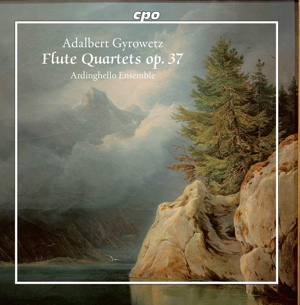
Adalbert Gyrowetz (1763-1850)
Flute Quartet in C, Op. 37, No. 1 (1799)
Flute Quartet in G, Op. 37, No. 2 (1799)
Flute Quartet in D, Op. 37, No. 3 (1799)
Ardinghello Ensemble
rec. 2020, Kirche St. Barbara, Nordweil, Germany
cpo 555 435-2 [59]
My first encounter with Vojtěch Matyáš Jírovec – Adalbert Gyrowetz’s original name in Czech – was on an old Crossroads LP licensed from Supraphon, which coupled him with another Czech Classicist, Václav Pichl. It was dull, and I soon passed the disc on to someone else. No doubt, my young, Romantically-inclined ears couldn’t yet process the Classical aesthetic, but the thick, tubby sonics. unfortunately typical of Supraphon’s late-1960s engineering, couldn’t have helped, either.
These flute quartets leave a much more favorable impression of the composer. (Pichl, whom I’ve never run into again, must fend for himself.) It helps that the “flute quartet” – a combination of solo flute and three strings – allows for greater transparency and variety than did that run-of-the-mill symphony. These are good, solid constructions, melodic and listenable, rhythmically buoyant. The occasional bit of counterpoint, like the flute’s back-and-forth with the violin in the C Major, enlivens the textures; so do those instruments’ deft scales in thirds in that score’s oompah-ish finale. The slow movement, in contrast, has a chorale-like gravitas. The G Major is similarly marked by the easy grazioso feeling typical of the period.
The Third Quartet, in D Major, actually transcends the garden-variety Classical tropes to approach the stature of Mozart. The Allegro moderato first movement begins gently – “moderato” indeed – as a leisurely 6/8 with some nice rhythmic swing, with the development shifting into the broad subdominant. In the stately Andante con variazioni, the flute launches each of the variations, including a mournful minor-key chorale; the closing Allegro, a sprightly duple, revives the cheer. It’s beautiful and distinctive, but never quite achieves Mozart’s ambiguous emotional layering, even in the minor passages.
Karl Keiser’s soft-edged, slightly chiffy flute tone gains in brightness in the upper octaves; his embellished recap in the Larghetto of the G major captures some of the grace missing from the strings’ earlier statement. The string players are capable, though they occasionally have to slow for their figurations, and the cellist is flummoxed by the occasional quick downward cadence. But I take exception to their presumably unmarked sectional ritards. They’re applied at appropriate places, and they’re not illegal in this style, but they always sound a bit tentative, as if the players hadn’t quite sorted them out. Conversely, they favor rushing into the final cadences of some of the Allegros, with no particular benefit.
Gently ambient engineering sets off the cool flute colour nicely against the warmer strings. I thought I heard a splice just before the flute launched the recap of the G Major. First-movement expositions are repeated, if you care about that sort of thing.
Stephen Francis Vasta
stevedisque.wordpress.com/blog
Help us financially by purchasing from





















